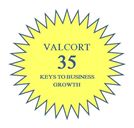Reaching the people most important to your business
Valcort 35 Keys to Business Growth: #19 Continuously evaluate the most effective way to reach each of the different customer groups you serve.
The easy part of marketing is to state a crisp, sensible plan for success: Whether we have a product that will be of interest to 10 or 10-million people, the most important task we have is to identify who those people are and how we can reach them with an effective message in the right context.
be of interest to 10 or 10-million people, the most important task we have is to identify who those people are and how we can reach them with an effective message in the right context.
The difficult part is answering each component question of that formula. Let’s take a look at these questions.
1. Who are these people? Identify the potential customer groups broadly, then methodically narrow to the different targets who are most likely to respond and most likely to use your product or service. Recognize that each group is likely to have slightly different characteristics, including the benefits we will provide and the way they engage us as a supplier.
Our goal is to find ways to identify who these people are so that we speak to them directly. This might sound pretty obvious, but too often we assume that what we offer the world has universal appeal and that our audience is “everybody!” As much as we would all like to believe that, it is really never true and that notion can keep us from reaching the right people.
- Characterize: We want to identify the factors that can be used to create a better connection between customers’ potential needs and what we offer. For starters, are there some demographic points that you can used–such as age, gender or geography–to begin to refine who the best recipients are for our products? How about criteria that matches a prospect’s beliefs, opinions, attitudes or intentions with your marketing message?
- Cull: Next, eliminate the people for whom an offer won’t be relevant or important. With these people out of the mix, we can now focus our marketing messages to reach the remaining people who are most apt to be interested and willing to take some sort of action when they come in contact with our marketing message.
2. How will we communicate with them? What’s the best way to reach your target audience?
- Identify the best channels to use to communicate with these people. There isn’t one right answer on the best channels we should use reach a target audience. For example, a local business looking for a local audience isn’t going to need to run a nationwide online search campaign to reach its target audience. Instead, it might rely on an ad in a local directory or even a small local newspaper to get best results.
- Start by thinking about how our target audience gets information. What channels do they use? Television? Radio? Newspapers? Webpages? Online search campaigns? We want to make sure that when our target consumers are learning about the world around them that our messages are part of that information stream.
3. What’s the most effective message? We need to figure out how we can fan sparks of interest into a flame, a lasting supplier-customer relationship.
- Focus on solutions: Customers are looking for solutions. And the best solutions address pain points and frustrations.
- Have a crystal-clear message: Write so you can’t possibly be misunderstood. Graphics can get attention, but don’t let them overwhelm your marketing to the point where your message isn’t being communicated clearly.
- What’s in it for the customer?: Standing out from the marketing clutter will always be a marketer’s challenge. Starting with fundamentals will help us break through. A great example — Holiday Inn Express advertised that their motels had the “number-one customer-rated showerhead.” Holiday Inn discovered through consumer research that good showerheads were important to their target market, so they communicated that message directly to them. We can listen and read all about the features of a Holiday Inn Express, but hearing about the number-one customer-rated showerhead speaks to something all visitors want. What’s in it for them? A superior shower.
4. Do these people want to do business with us?
How do our prospects make decisions—positive and negative? People make choices that are consistent with their values. While we certainly want to promote our brands and services in a positive light, we also need to be willing to identify with our customers.
While it is helpful to look at our brand through the eyes of our customers and the filters they bring to the relationship, perhaps the biggest mistake we make is seeing these people as drastically different than we are. Frankly, we’re not that different. We all make decisions about a product, a service and who you’re going to do business with essentially the same way. We make choices on the basis of our values.
We will connect most easily with others with whom we share values, because this builds trust. And trust is the essential currency of commerce. When people trust us, they can listen to our messages about our brand and about the benefits our product and services.
____________________
 The Valcort 35 Keys to Business Growth. Over many years and hundreds of client relationships and strategic marketing opportunities, we have established the Valcort 35 Keys to Business Growth, best practices that build trust, align values with products and practices, and create organic growth. We are exploring these 35 practices, one at a time, on these pages. Find them all, as they’re introduced, here.
The Valcort 35 Keys to Business Growth. Over many years and hundreds of client relationships and strategic marketing opportunities, we have established the Valcort 35 Keys to Business Growth, best practices that build trust, align values with products and practices, and create organic growth. We are exploring these 35 practices, one at a time, on these pages. Find them all, as they’re introduced, here.





